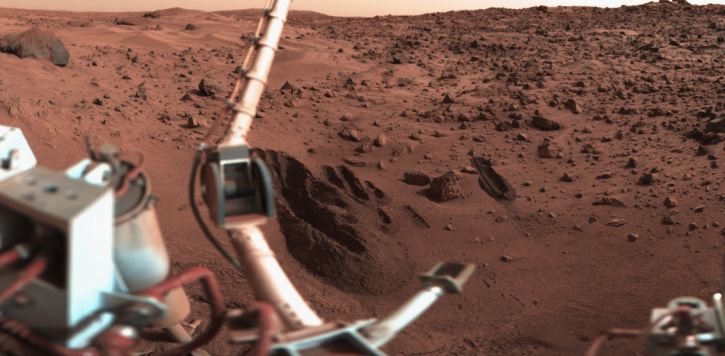Mars Landing: Questions Viking 1 Never Answered
Forty years after landing on Mars, we know more about our universe than ever before—but the answers to the most important questions of all still elude us.
The Viking 1 Lander creates trenches as part of its surface composition and biology experiments on Mars on May, 26, 1977 (NASA).
The red landscape stretched on in every direction, as far as the eye could see—but, of course, there were no eyes there to see anything. The rocks were still; red dust milled about, conveyed by the wind. Mars was, as ever, desolate. Totally barren.
And then, exactly seven years after humanity took its first step on the moon, an odd-looking machine came parachuting through the Martian atmosphere. It was the Viking Lander 1, a curious bundle of scientific equipment designed to explore and analyze the mysterious red planet. With the help of its counterpart, Viking Orbiter 1, Lander 1 would relay data and images to a team of scientists waiting eagerly back on earth.
The Lander 1 was the first man-made object to land on Mars intact. The information it gathered would change the way we looked at our neighboring planet forever. It was a historic moment, a moment of incredible importance in the history of the human race—our first interaction with the surface of another planet.
That moment was 40 years ago today.
What is man?
Let’s rewind the clock a little further. Thousands of years before Viking 1 landed on Mars, a shepherd boy was lying out in a field with his flock, staring up at the stars and ruminating on his place in the universe. Later, that boy—David (of David and Goliath fame)—would go on to record his thoughts in the form of poetry and psalms. Here’s an excerpt from one:
O LORD, our Lord,
How excellent is Your name in all the earth,
Who have set Your glory above the heavens! …
When I consider Your heavens, the work of Your fingers,
The moon and the stars, which You have ordained,
What is man that You are mindful of him,
And the son of man that You visit him?
David looked up at the vast expanse of the night sky—an infinite swath of stars peppering the inky blackness of space—and wondered, “Why us?” Out of such a mammoth expanse, why earth? What makes us special? What sets us apart?
Millennia later, we are still asking the same questions.
David looked up the vast expanse of the night sky—an infinite swath of stars peppering the inky blackness of space—and wondered, “Why us?”
Our collective comprehension
When President John F. Kennedy addressed the crowds at Rice University in 1962, he spoke of what he saw as the United States’ need to win the space race: “We choose to go to the moon. We choose to go to the moon in this decade and do the other things, not because they are easy, but because they are hard, because that goal will serve to organize and measure the best of our energies and skills, because that challenge is one that we are willing to accept, one we are unwilling to postpone, and one which we intend to win, and the others, too.”
Ostensibly, President Kennedy’s goal was to establish the United States as a space power so that it would have a greater say in the future of that arena. But there was something else too. In his own words, “the vast stretches of the unknown and the unanswered and the unfinished still far outstrip our collective comprehension.”
Even now, over half a century later, that remark still holds true. There are so many things we still don’t know—so much about the universe that eludes us, that rests just beyond our grasp.
Forty-seven years ago today, we put a man on the moon.
Forty years ago today, we put a lander on Mars.
A little over two weeks ago, we put a probe into orbit around Jupiter.
Why? To understand. To explore. To see. To wrap our minds around the vast stretches of the unknown and to see if we can’t find an answer to that one question that’s been burning in our collective comprehension for millennia:
Why us?
Alone in the universe
We won’t find our answer among the planets and stars, though. We didn’t find it when we stepped out on the moon and planted a flag. We didn’t find it when we sent a lander to Mars to search for signs of life. And we’re not going to find it when the Juno probe peers into the heart of Jupiter. In fact, the more we gaze into the universe, the more the universe seems to remind us of how unique and special we are. (For more on this, see our article “Are We Alone in the Universe?”)
“What is man that You are mindful of him?”
Answering the question
The answer won’t be found among the planets and stars, but we can find it within the pages of the Bible. God answered that question long ago—long before we landed on the moon or Mars, and long before a young shepherd boy found himself staring up into the night sky:
“Then God said, ‘Let Us make man in Our image, according to Our likeness; let them have dominion over the fish of the sea, over the birds of the air, and over the cattle, over all the earth and over every creeping thing that creeps on the earth.’ So God created man in His own image; in the image of God He created him; male and female He created them” (Genesis 1:26-27).
God created the human race—that’s you, that’s me, that’s everyone who’s ever lived—in His own image. It wasn’t an afterthought, either. God is mindful of us because He created us for a purpose. And what is that purpose?
He’s expanding His family. It’s found throughout the pages of the Bible: He intends to bring “many sons to glory” (Hebrews 2:10), He calls His faithful followers His children (1 John 3:1), and says if we are “children, then heirs—heirs of God and joint heirs with Christ” (Romans 8:17).
You exist because God wants you in His family.
The truth is as simple and as profound as that. It’s the answer to the question burning in the hearts of kings and shepherds, and it’s the framework for understanding life’s most difficult questions. No matter how far we venture into space, no matter what secrets we unlock on the planets we visit, nothing can trump the incredible truth that we were created to become the children of the God who created it all.
To learn more about the purpose of your life, read “Why Were You Born?”
Date Posted: July 20, 2016

 by Jeremy Lallier
by Jeremy Lallier

